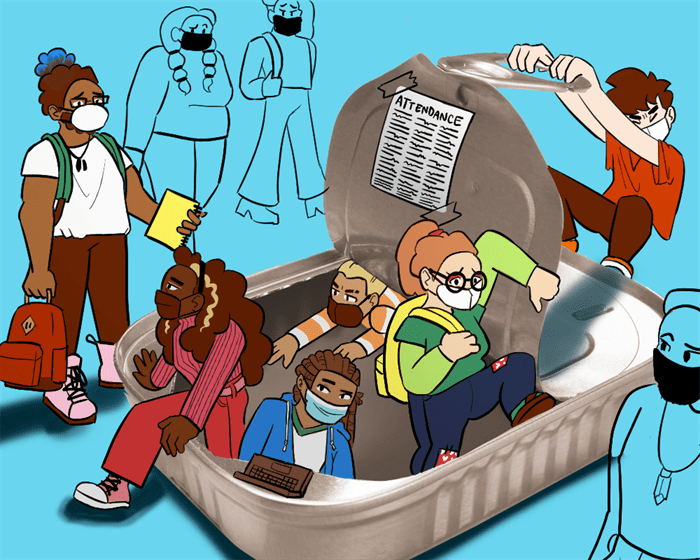Crowded classrooms are common at many large colleges, and Montclair State University is no exception. Anyone who has tried to take a popular course knows the adrenaline rush that comes with getting in, as well as the quiet desperation of hoping the course won’t fill up before you can register. One can easily go their entire college career never having taken a much-desired course because of these capacity limits.
With the largest-ever freshman class having been accepted in the fall semester, classrooms seem more packed than ever before. In the era of the coronavirus (COVID-19) pandemic, this is not only a frustrating reality but a concerning one when it comes to in-person learning.
Being squeezed into a small classroom with dozens of other students used to be a source of anxiety or annoyance at worst and an exciting opportunity to socialize at its best. But now, even fewer people are eager at the prospect. COVID-19 is, after all, an airborne illness that necessitates keeping your distance from others, especially in large groups.
One popular class, Introduction to the Film, has a capacity limit of 120 students. This isn’t unusual for a lecture-based course, especially one centered around an audio-visual medium. But the room it is held in, located in Calcia Hall, is a tiny auditorium, about the size of an average black box theater.
Students are seated shoulder to shoulder, so close that one could easily accidentally elbow someone in the face while taking off their coat. The only social distancing relief comes from the occasional broken chair.
Masks are obviously important in such a scenario. But with over 100 people packed together like sardines, it feels like masks can only do so much. It’s difficult to feel at ease being so close to so many people when the importance of social distancing has been etched onto our collective psyche.
In an Instagram poll taken by The Montclarion, 63% of 286 students said at least one of their classes felt too crowded or unsafe due to being overly full.
Safety concerns regarding packed classrooms seem to disproportionately affect those in older buildings such as Calcia Hall or Dickson Hall, where rooms and desks are small and neglected infrastructure can mean a lack of even basic ventilation, like windows. Such disparities are apparent when traveling between buildings; having a class in the Feliciano School of Business or University Hall can feel like a mocking kind of special privilege if you’re used to the windowless boxes of Dickson.
Students can choose to avoid other potentially crowded spaces, such as dining areas. But without a missive from Hawk Check to stay home due to possible COVID-19 exposure, coming to class is not optional.
Not only is being physically absent from class largely impossible due to the university’s insistence on continuing in-person education, but the other precautions put in place to keep students safe seem moot if they are just going to be crammed into tight quarters with each other. After all, it has been proven time and again that one of the most effective ways to avoid contracting COVID-19 is to stay six feet away from other people.
Classroom crowding is no longer simply an inconvenience but a matter of safety. Preaching the need for social distancing becomes an act of thoughtless hypocrisy when students are placed into learning environments that make such precautions impossible to take.
Holding courses like Introduction to the Film in a larger room, for everyone’s comfort and well-being, is just one of the basic adaptations that Montclair State can and should make. Such classes are typically longer in duration, which underscores the need for as much space between people as possible. The more time spent near large groups, the higher the risk is of getting sick.
Montclair State can also accommodate its campus population by providing better masks, such as medical-grade N95s, KN95s or KF94s for free, on account of the highly contagious nature of the omicron variant. This would go a long way toward reassuring students and employees that they are at least protected in high-density areas of campus, as well as lifting some of the financial burdens of having to constantly procure new masks.
With 109 COVID-19 cases in total on campus, Montclair State’s numbers are not out of control, but they are still higher than they were before winter break. Students have exercised a commendable amount of caution so far, but the fact remains that we could all use a little more space.



